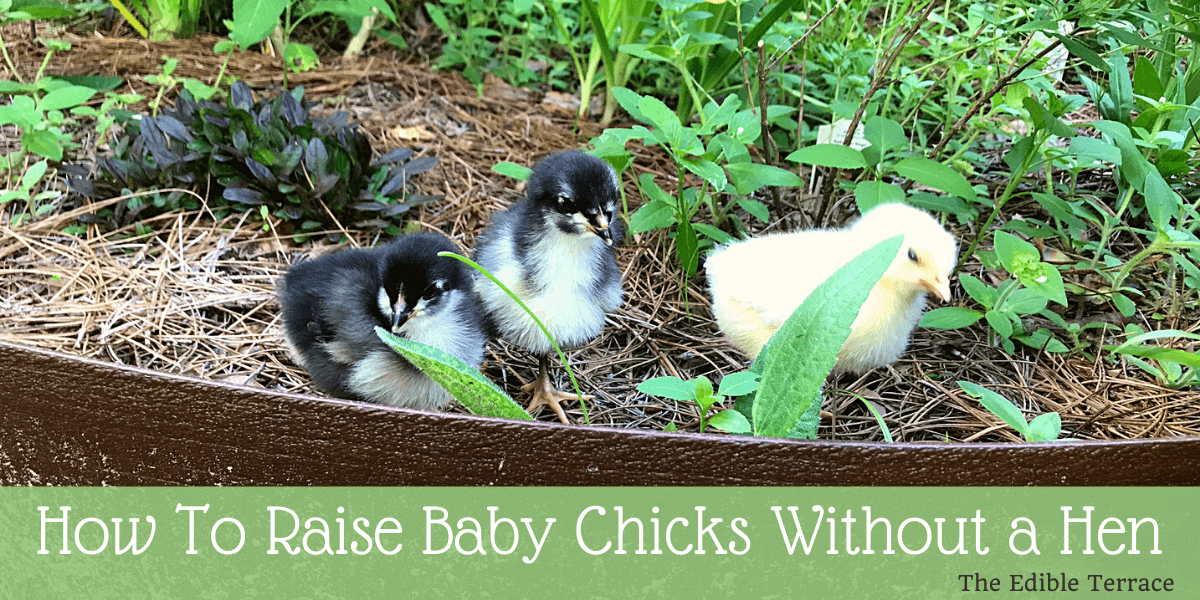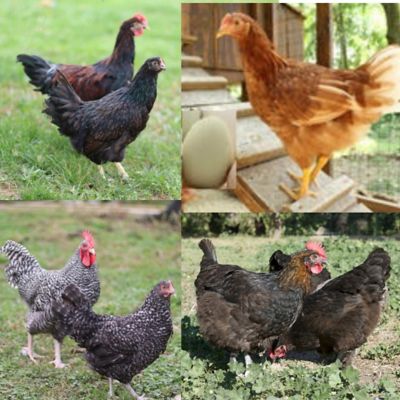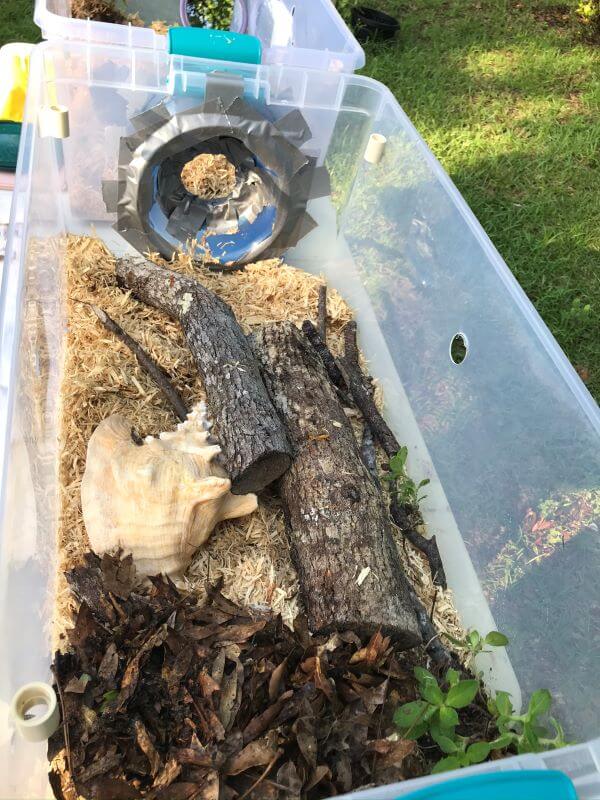Hey! By the way… TheEdibleTerrace is reader-supported. When you buy through links on our site, we may earn an affiliate commission and as an Amazon affiliate, we earn from qualifying purchases. Thanks in advance for your support!

For those of you who follow me on Facebook or Pinterest, you know I have mainly focused on edible gardening but COVID-19 opened my eyes up to a few areas in my life that needed some shoring up. One of those is a too heavy reliance on the grocery store to feed us. Sooo, as vegetarians who eat eggs (and we do eat a lot of them), we decided getting chickens was a wise place to continue this journey toward more self-sufficiency.
May I first introduce you to my girls (cuz I’m dying to do so!)? The Amberlink is Daisy (named after my grandmother), Flory (the larger of my two Australorps with the biggest personality and also my grandmother’s sister) and Plumie who is my smallest and biggest scaredy cat (I almost said ‘biggest chicken’ but thought I would behave myself). I am completely besotted with these three but they take a lot of work.
Do you want to know how to raise baby chicks without a hen? Of course you do!
There are three options when it comes to raising a baby chick at home.
Getting chicks from a store is how we decided to do it. Our local Ace Hardware has a bonafide “chicken expert” on staff (Oh, country living…) so we went there. However, if you don’t have a place near you, a store like Tractor Supply does carry them and will even ship them to your home.
Baby Chick Starter Kit
- Order Live Chicks Here
- Some kind of a pen or container to hold them. We connected end to end two 106qt storage containers (pic below) from the local Dollar Store. They were $13/ea. 💪
- Pine Shavings
- Radiant Heat Lamp
Food and water containers:
- You will need two 1 quart Little Giant Screw-On Poultry Jars.
- One Feeder Base
- One Waterer Base
- Purina Start & Grow Crumbles with Medication
- Fun toys to occupy them. Mine are totally free. I bring in dirt, fallen leaves, logs and even grass clumps from the yard and then switch it all out frequently.
Regardless how you get them, make sure they are in good shape and free from disease or sickness.
- They should not have any mucus coming from their nose or eyes or be swollen in the eye area.
- They should not be sneezing or coughing, or weak.
- If you notice that mail-order babies arrived in poor condition, notify the post office and the place from which you ordered them. Many times you can get refunds for those that won’t make it.
The second option is to order fertilized eggs. This will require an incubator though. Eggs will take about 21 days to hatch. Be sure to have the second stage of shelter ready to go before the eggs hatch. Chicks that are hatched inside an incubator must stay inside the incubator for a couple of days. An incubator should have a temperature of at least 98 – 99 degrees.
To measure the humidity inside the incubator, use a [easyazon_link identifier=”B01H1R0K68″ locale=”US” tag=”raising-bkyd-chickens-20″]hygrometer[/easyazon_link] or a thermometer. For the first 1-18 days, the humidity can be at least 50% and the remaining days till day 21 must have a maximum of 80%. You should maintain adequate moisture inside the incubator. To do this, you can use paper cups or a pan containing water. To evenly apply the heat, mark the eggs with an O on one side and an X on the other side. This will help you keep track of which side needs to be heated.
Do this process at least three to four times a day. If you started heating all X sides, the next time you turn it, all sides will be O. Do not skip until hatching day comes or else the eggs will be deformed on the inside. Sometimes, eggs will not hatch due to either not being fertilized or deformed. Just like human babies, it takes time for chicks to adjust to the outside world.
Are you still agonizing over which chicken coop to get?
Provide food and water but expect that they may not be interested initially. Birds like quails, pheasants and chickens can survive for three days without any source of water or food. Right before they hatch, the yolk in the egg is drawn inside the chicks’ body for nourishment outside of the eggshell.
Chicks will begin to experiment with their environment and may peck at the other chicks as they transition. Once you notice this behavior, the chicks can be removed from the incubator and placed in their bed or brooder with a heat lamp.
Your third option is to hatch chicks in your own backyard. Once you have an established flock with a rooster and hens, you can then hatch your own chickens. Regardless of the option, you choose there are a few guidelines you should keep in mind for your chicks.
🏡 Chicks have 5 basic needs: shelter, comfort, warmth, food and water. 🌞

Hoover’s Hatchery Assorted Color Egg Produ…
Hoover’s Hatchery Assorted Color Egg Production Chickens, 10 Count Baby Chicks [More]
How To Raise Day Old Chicks

Our “custom made” chicken brooder box
Shelter. Shelter requirements are important to follow with chicks as they can easily succumb to stress. When they are chicks, providing shelter in a large plastic tote without the lid will suffice. Add some bedding such as straw or pine shavings (I use pine shavings) to soak up the waste products. Cedar chips should not be used for chickens since they are toxic to them.
In addition, provide enough space so the living quarters are not cramped. Cramping might result in trampling or worse, cannibalism. Chicks grow quickly. That’s why you have to ensure that their home is large enough for their proper development.
You will also want to clean out your chick’s shelter at least once a week. The older they get, the smellier their pen gets! We put a ton of pine shavings in ours and after 4 days or so, you can definitely get a nice aromatic odor as you walk by. (At approx. 4 weeks, we started cleaning their “condo” twice a week.)
Curious about our DIY chick brooder? We connected two 100qt storage containers (from the Dollar Store) end to end (pic to the right) and then put up a pvc framed screen (using deer netting) after only a week because they began trying to fly so soon (I have a sneaking suspicion our Amberlink was more like a week old when we got her because she advanced much quicker than the other two).
I also add in fun toys like wood pieces from the yard, chunks of grass and dirt and a mirror (which they love btw). I frequently drop a bucket of dirt into the condo as well so they can pick through it and take more of those cute dirt baths.
What Do I Need To Raise Baby Chicks?
Comfort. Providing comfort for chicks is simple. Chicks can be comforted by being held or by hanging a feather duster upside down in their shelter. The feather duster simulates a mother hen. Holding chicks while they are babies ensures that they will be friendly as they grow into chickens. I also talked to them often – especially when it sounded like they were stressed out. That really did seem to calm them down.
Now, having said that, you must, must wash your hands after you hold them – especially if your kids/grandkids hold them. Chicks are known to spread salmonella. You don’t want that. Talk about ruining a day!! Don’t underestimate this please!
Keeping baby chicks warm. Warmth is essential for chicks. If it is cold outside, keeping chicks inside is a good idea. The cold air can inadvertently lead to their demise. Warmth can be provided by a [easyazon_link identifier=”B01LX9K1JI” locale=”US” tag=”raising-bkyd-chickens-20″]heat lamp positioned above the shelter[/easyazon_link]. Before you get your chicks, heat up their bed area. Ensure that the heat lamp is from 18- 27 inches above the chicks, depending on the warmth of the surrounding air. The first week, the incubator must have a temperature that is 90-95 degrees. The temperature must decrease every week by 5 degrees until you reach the 6th week.
If the chicks are hatched from your hens, then the mother hens can provide all of the comfort and warmth that the baby chicks will need.
What kind of heat lamp do you need for chicks?
[easyazon_image align=”left” height=”370″ identifier=”B01LX9K1JI” locale=”US” src=”https://m.media-amazon.com/images/I/519IxsmGTWL.jpg” tag=”edibleterrace-20″ width=”400″]Here is our heater. K thought it was the best option because it would not melt the plastic of the storage boxes and also spread the heat out, so the chicks would have plenty of room underneath. (Mouse over the image of the heat lamp to see the current Amazon price)
Temperature Chart For New Chicks
| Age of Chicks | Recommended Temp |
| Prior To Hatching | 95F |
| Hatch to 1 week | 9oF |
| 1-2 Weeks | 85F |
| 2-3 Weeks | 80F |
| 3-4 Weeks | 75F |
| 4-5 Weeks | 70F |
CUTENESS ALERT! Check out the girls taking their first dirt bath! 🥰
What do you feed chicks?
 When it comes to food and water, that can be provided using feed and feeder equipment from someplace like Tractor Supply or your local hardware store (if its anything like ours anyway).
When it comes to food and water, that can be provided using feed and feeder equipment from someplace like Tractor Supply or your local hardware store (if its anything like ours anyway).
The type of feeder needed for chicks varies from that needed for full grown chickens due to size. It is important to clean the feeding and drinking stations at least a couple times a week for sanitary reasons.
Additionally, make sure the chicks cannot lay in or spill the water. Adding 3 tablespoons of sugar per quart of water is recommended for the first few days in order to give the newly arrived chicks’ energy. Dipping their beak in the water will help them to realize what the water is for.
Provide water in a very shallow container so the chicks do not drown. They like to get in the water since they just came from a very moist environment inside the egg.
Our food and water containers consist of 2 – 1 quart Little Giant Screw-On Poultry Jars. One has a feeder base and one has a waterer base. I compared the prices between Amazon and Tractor Supply and TS won out.
The feed will vary depending on the age of the chicks. Chicks are usually started on what is called a starter feed. In order to satisfy the pecking instinct, some starter feed can be sprinkled on a plate or a piece of cardboard.
Be sure to clean up loose feed daily in order to avoid the growth of mold. Feeding chicks randomly with bread or other human food is not recommended. Instead, feed them a commercially prepared feed in order to ensure proper growth and development.
You can also add a tiny bit of fine chick grit to their food. This will aid in digestion. One food that can be included in their diet as they get bigger is lettuce. And squeamish or not, you should also provide their favorite food – bugs and grubs.
This is what Ms Alyse, our resident chicken expert at the local Ace Hardware, sent home with us to feed the chicks for the first several weeks. It’s Purina brand Start & Grow Crumbles with Medication
Per Ms A, medicated was VERY important for their future health!
Close observation during the first few hours after the arrival of your chicks is necessary to ensure their safety and health. You may need to adjust the heat lamp, move them to another room or rearrange the equipment in their bed area for maximum movement. Make sure they are eating and drinking by keeping tabs on the water and food level each day.
Things To Know About Raising Chickens
Raising chickens can be a dirty job and is hard work at times. Hold on tight though because the benefits of having chickens are coming your way soon. You might be wondering what to expect as the chicks grow.
Growth
Chicks grow very fast. One day you are placing them into their bed for the first time and seemingly the next, you are introducing them to their coop. Within a few short weeks you will notice changes in your chicks. They will start to shed their fluffy overcoat and feathers will begin to show. If you have a rooster, either intentionally or by accident (as often happens), he will start to grow a comb and wattle and look different from the hens. He may even stand on something higher than the hens and try to crow to show his kingship (cutest thing ever btw – video below – you’re welcome!).
Egg Laying Time
You can expect the young hens, called pullets, to start laying eggs around 18 weeks. These early eggs will probably have a thin shell and may be smaller than the eggs of a mature chicken. Longer periods of light, either artificial or natural, encourages the hens to start laying. At this point their feed should be switched to a “layer” feed along with a calcium supplement in order to make the shells harder. This can be purchased at Tractor Supply. Remember that a rooster is not necessary for the hens to lay eggs, only for the eggs to be fertilized. If you have a rooster and do not want mature fertilized eggs, be sure to keep an eye on the nesting boxes for the eggs and collect and eat them as soon as possible.
Hierarchy
Chickens are very hierarchical. The hens will have a pecking order and will decide who is the top hen and who is the bottom hen. Sometimes the other hens will ostracize the bottom hen and not allow her to be with the group. The rooster will often protect this hen from the rest of the flock by making her stay in a safe place such as the porch or the pen while he goes out and protects the rest from predators. Beware if this sole hen makes a noise indicating she’s in trouble. The rooster will come running to help her and those near her should leave the area in order to avoid the wrath of the rooster. Roosters provide great protection for hens, especially if they are free-range chickens.
Molting
At about 16-18 months, you may wake up one morning and notice that one or several of your hens look ragged. They have feathers missing and look like they’ve been dragged behind a tractor. 🚜 This phase is called molting. During this time, the hens will lose their feathers and grow new feathers. It happens in response to decreased light at the end of summer or beginning of fall. The chickens may also stop laying eggs during this time and become grumpy. This is a very painful time for them so minimize handling and reduce their stress level. Ensure they are getting optimal nutrition and allow them extra artificial lighting in their coop. If they have not stopped molting at the end of 12 weeks’ timeframe, they should be seen by a vet as they may have a parasite.
Brooding
Brooding is another alarming phase for chicken owners. It is when hens decide they will not get off the nest for any reason and develop an attitude toward their owners and the other chickens. It is a natural instinct that allows them to hatch eggs in a shorter time period. If you are trying to hatch eggs from your flock, then let them be and provide extra nesting boxes so each hen can have her own box. Ensure she is eating and drinking which might require moving her to her own coop so you can monitor her nutrition.
Once one hen becomes broody, the rest will soon follow as this is a contagious attitude. If you do not want the hens to be broody or you do not have a rooster to fertilize the eggs, it is essential to “break” the attitude. To do this you may need to move her to another area with no nesting boxes but with access to food and water. You should also collect eggs soon after they are laid to prevent this behavior from happening.
In essence, that’s about it.
[easyazon_image align=”right” height=”350″ identifier=”B07VPPNMJP” locale=”US” src=”https://m.media-amazon.com/images/I/51gXPcjRI1L.jpg” tag=”raising-bkyd-chickens-20″ width=”350″]Chicks are like babies. They eat, they drink, they doodoo a lot. They are cute and fun. We actually kept our chicks in our living room until they got old enough to move to the coop. Loved their antics! We would enter the room and they would run from one end of their chick condo to another and just look at us. When they couldn’t see us, they would chirp really loudly. At bedtime, they got really loud! I swear it sounded like we had 30 instead of 3 chicks during those times.
You will get more attached than you know and soon your friends will start sharing everychickenvideo they find on Facebook with you as well as any accessories they come across. This can be anything from chicken diapers to dresses to strollers.
Learning how to raise baby chicks without a hen isn’t that hard once you get all the know-how. You need to keep them warm, fed, watered and protected. Be patient and in no time the chicks will pay you back 10-fold with recurring nutritious goodness!
Do you have any questions? Did I miss anything important? Let me know if the comments below!
